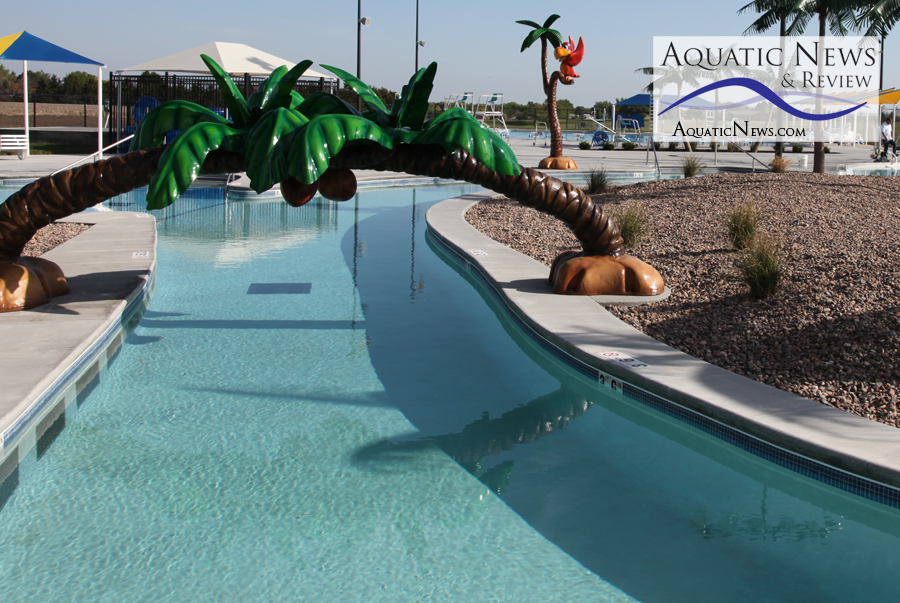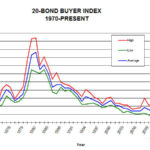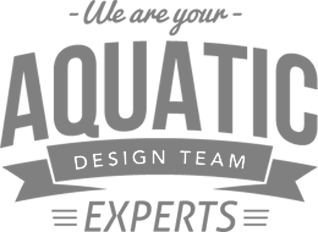This is one of the most misunderstood topics I know of when it comes to swimming pool construction. Let me start out by stating a fact that everyone should know:
“All of these products are concrete!”
Shotcrete, “concrete”, and gunite are all basically the same product with variations in strength, inherent water-tightness, and methods of construction. (Be sure to watch video of gunite being installed, at the end of this article.)
I don’t know how many times I have heard people who are looking to build a new aquatic facility tell me that they want a concrete pool and not a gunite pool, or that they want a shotcrete pool and not a concrete pool.
The first thing everyone needs to know is that these three terms, that are thrown around so carelessly, are actually different forms of concrete with different strengths and weaknesses as it relates to swimming pool construction.
The second thing you should know is that each type of concrete has important applications when it comes to aquatic facility construction. Limiting the design of your facility to just one of these three technologies just because a “pool designer” or someone else told you a particular product is the best, without knowing the facts for yourself, is a mistake many facility owners make. This article is intended to shed some much needed light on this subject so that aquatic facility owners, or potential owners, can make the wisest possible decisions that are in their best interest.
Concrete is basically man’s version of making a very strong rock. Various forms of concrete have been in existence since the time of the Assyrians. The Roman Empire made great strides in constructing many types of structures out of crude, but effective, forms of concrete.
Concrete, or manmade rock, is created by using small pieces of natural rock in various forms and sizes that we refer to as aggregate. To form concrete, this aggregate is mixed with some sort of bonding material that holds all of the smaller rock particles together and solidifies into a usable structure of the dimensions needed. The overall strength of the manmade rock, or concrete, depends on how effective the bonding material is at binding the aggregate together.
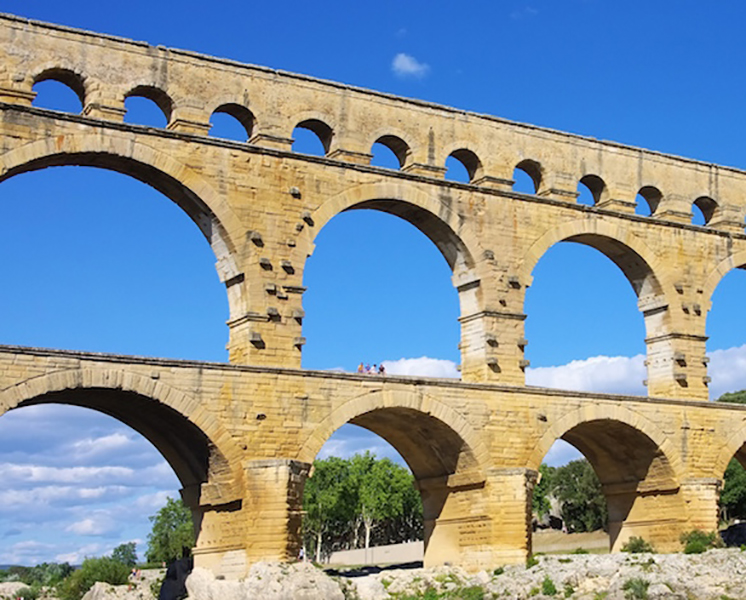
In ancient times the bonding materials used to form concrete consisted of elements like clay, lime, or gypsum. In 1824 Joseph Aspdin invented what is called Portland cement as a new and much more effective bonding material. Improved and perfected formulations of Portland cement are what we use today as the bonding material that holds aggregate together to form very strong “concrete”.
For any type of construction, including that of swimming pools, the differences in concrete come from the specific formulas we, as aquatic facility engineers, design. In a modern and typical concrete formula, there are four basic categories of materials, cement, aggregate, water, and admixture chemicals. During the design process, we create formulas for concrete to meet the needed application and the structural performance we require from the concrete.
Each time we design an aquatic center, we customize the various concrete formulas to meet the strength and water-tightness characteristics necessary for properly constructed swimming pools. While designing the concrete formulas, our engineers take into consideration the aggregate materials available in the geographic area of the aquatic center and the type of concrete application that best fits the project, shotcrete, gunite, and/or cast-in-place concrete. All three of these concrete construction methods will be described in detail as part of this article.
In swimming pool design, we are concerned with two main performance categories related to concrete for our pool walls and floors. These performance categories are strength and water-tightness. Most of the problems I have seen over the years with concrete pool structures relate to the lack of understanding of how to properly design concrete formulas that result in strong and watertight swimming pools.
So, now that I have given you a basic overview of concrete, we need to explore the differences between shotcrete, gunite, and “cast-in-place” concrete. Cast-in-place concrete is what most people mean when they say “concrete”.
“Cast-in-place” Concrete
Cast-in-place concrete is the category of concrete that is installed by building a form, usually out of wooden boards or steel, and then pouring the wet and runny concrete mixture into the form before using tools to smooth out the surface. The concrete then dries, through the act of water hydration, and hardens into a solid structure.
In the case of an aquatic facility, our concrete structures are typically floors, walls, decks, and sometimes elements like diving platforms, water slides, water play features, or hard landscape items around the swimming pools.

Installing concrete by the “cast-in-place” method is one of the most common practices in the entire construction industry and is therefore comfortable to many designers and contractors.
However, please keep in mind a very important point here. Just because doing something over and over the same way may be “comfortable” to a contractor or designer, does not necessarily make the procedure the best application when building a swimming pool that must be strong and watertight. The use of cast-in-place concrete does have a place in pool construction, but in most cases, shotcrete or gunite should be used as well for the best possible result.
One of the drawbacks to using cast-in-place concrete for everything in swimming pools comes from the fact that the concrete mixture for cast-in-place has to contain a large volume of water so that it can be poured into the forms. Being able to “pour” the concrete is critical to getting the proper thickness of concrete in all places and to be able to smooth out the surface of the concrete.
The real problem with having a large volume of water in the concrete is that to form hard concrete, the water reacts with the cement in the concrete mixture to cause high heat during the act of hydration. This high heat causes the water to evaporate from the concrete with a resulting decrease in overall volume of the concrete as it hardens.
This decrease in concrete volume is a characteristic of concrete formation and something that concrete designers must be aware of. To account for this volume loss, we must design joints between concrete sections of the pool in order to control cracking in the concrete. Unfortunately in swimming pools, having joints or cracks is not at all desirable when we are trying to make pools water-tight.
Having joints in a concrete pool is unavoidable if the pool is large. Proper design of joints, which includes waterproofing materials of various sorts, between concrete sections can result in nice watertight pools, at least initially. However, over time most joints must be maintained properly in order to remain waterproof. If the joint is poorly designed or constructed, which happens way more than you may think in this industry, the joint has the potential of being a huge source of water loss.
Water loss around or under a pool is undesirable for many reasons such as the cost of wasted water and chemicals, or the creation of subsurface voids under the pool structure when migration of leaking water removes supporting soils. Voids in and around pools can cause pools to actually break apart or decks and piping around the pools to settle or break.
A rule of thumb to remember when designing swimming pools is to minimize the number of separation joints between concrete sections in the pool!
Of the three methods of concrete construction, cast-in-place tends to be the most expensive for swimming pools. The main reason for this comes from the fact that forming, pouring, and finishing cast-in-place requires more labor and materials.
On the positive side, cast-in-place, when constructed on a horizontal plane such as on a pool floor, will result in the most uniform surface of the three methods. That is why most aquatic designers will utilize cast-in-place concrete for pool floors.
Pros & Cons of “Cast-in-place” Concrete
Pros
- It is hands down the most common type of concrete construction. This means that most contractors have experience with concrete installation using this technique.
- If designed properly, which is a big if from what I have seen during my design career, cast-in-place concrete can result in a strong and waterproof structure, when considering the concrete surface itself and not the joints between concrete sections. Typical compressive strengths of the concrete in cast-in-place pools are 4,000 to 5,000 psi.
- If properly designed and constructed, this form of concrete results in a relatively smooth surface that with proper preparation can readily accept epoxy-based pool painting systems. If cast-in-place is used for verticals walls, care must be taken however, to eliminate pitting that often occurs when forms are removed from the pool-side of the wall. These pits must be filled and smoothed with materials that are compatible with the concrete and the finish surface treatment of paint or plaster.
- When used for pool floors, cast-in-place concrete results in the most uniform surfaces possible. Since a pool floor does not have a form for the top surface, pitting, as a result of form removal, is not an issue. Cast-in-place is actually the best method for most pool floors because of these facts.
Cons
- The biggest drawback to exclusively using cast-in-place concrete in a swimming pool is the amount of water that has to be used in the concrete mix formula so that the concrete can be “poured” into the forms. This results in a large number of separation joints between pool sections when compared with the other concrete types; shotcrete and gunite.
- Strong concrete, but it is the weakest of the three methods.
- With cast-in-place, it is harder and much more complicated to form shapes other than straight rectangles. Most modern swimming pools have various shapes and curves to add character, interest, and greater functionality to the designs. With shotcrete or gunite such shapes are constructed easily.
- Cast-in-place is generally more expensive to construct than shotcrete or gunite.
Shotcrete Concrete
Both shotcrete and gunite are what is referred to as “free form” applications of concrete. Free form, by its very nature, enables concrete to be used to create very strong and watertight structures following any type of geometry. The concrete can be applied horizontally or vertically and can even be shot upward to adhere and form to the underside of a ceiling.
Shotcrete and gunite products have been used since the turn of the 20th century in applications such a tunnels through mountains for roadways. Many of the interstate tunnels you may have driven through were constructed using these forms of concrete.
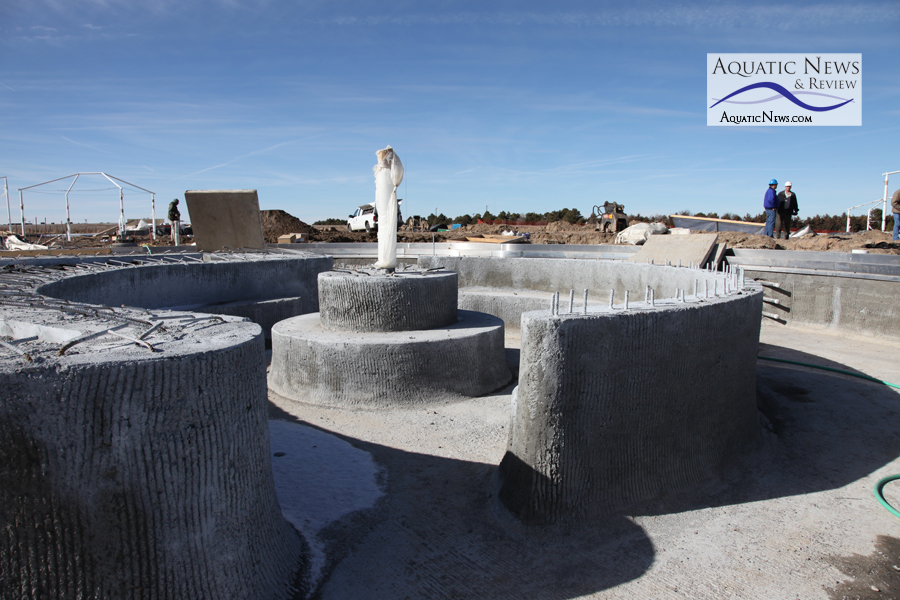
With shotcrete, the entire concrete mixture is combined at the concrete plant, including the water in the mixture, before being transported to the jobsite in concrete trucks. This is the same procedure that is used for cast-in-place concrete with the exception of the lower water content in the shotcrete mixture.
Once the concrete arrives at the jobsite, it is poured into the shotcrete pump and sprayed under pressure into place in layers through a back-and-forth motion of the nozzle. The shotcrete application continues until the designed wall thickness is achieved.
The result of using shotcrete for swimming pool walls is a much stronger wall with fewer joints between wall sections, than with a cast-in-place wall.
One thing that must be considered when using shotcrete in pools is the experience factor. It is critical with any construction that the contractor building the pool be highly experience with the methods of construction being used. With shotcrete, the person operating the shotcrete hose and nozzle is the absolute key to getting a great result from the concrete.
When done properly, shotcrete results in a much stronger and watertight installation than with cast-in-place. If constructed incorrectly, any form of concrete work, including all three methods, will be disastrous. It is imperative that the swimming pool contractor hired for the concrete work be highly experienced with the chosen method of concrete construction.
Pros & Cons of Shotcrete Concrete
Pros
- When properly designed and constructed, shotcrete (or gunite, which will be discussed next) will result in the strongest and most watertight concrete pools possible.
- Because of the lower volume of water used in the concrete mixture, there is less volume change from water hydration, which results in much fewer joints in the pool. Remember the rule of thumb for good pool design and construction is to “minimize the number of pool joints between concrete sections in the pool.”
- Higher compressive strengths than cast-in-place concrete. Typical compressive strengths of shotcrete are in the range of 6,000 to 7,500 psi.
- “Free form” application makes it possible to build very strong and watertight structures of any shape.
Cons
- Like all concrete installation, the contractor must be experienced and skilled in the particular technique of installation. There are fewer people skilled in the use of shotcrete than that of cast-in-place concrete.
- The finished surface of shotcrete is generally a bit rougher than with cast-in-place concrete. Because of this, most shotcrete pools have a finished surface consisting of a pool plaster material or Diamond Brite as opposed to epoxy-based pool paint.
- It is not that epoxy pool paint is better than pool plaster, it is just a fact that paints generally will not look as good when applied to shotcrete walls as opposed to cast-in-place or gunite concrete with a smoother finish. Most people prefer pool plaster type finishes, but epoxy paint is generally cheaper to initially install.
- Few pool designers actually understand how to properly design shotcrete or gunite in swimming pool structures. The only reason this is listed as a con is the fact that the number of truly qualified concrete pool designers is limited to a few. It is more an indictment of limited design knowledge than it is of shotcrete or gunite concrete.
Gunite Concrete
Like shotcrete, gunite is a form of concrete that is applied to a surface pneumatically. The formula for concrete in a gunite application has a higher percentage of cement and a lower amount of water than that of “cast-in-place” or “shotcrete” concrete. Like shotcrete, the formula results in a concrete mix that is dry enough to be applied to vertical surfaces such as pool walls.
Gunite concrete is often times referred to as “dry gun” concrete. The reason for this label is the dry nature of its application. Unlike cast-in-place and shotcrete, with gunite the dry portions of the concrete are mixed at a concrete plant, or at the jobsite, before being applied. There is no water added to the dry concrete mix until actual application from the gunite nozzle.
Gunite equipment forces the dry concrete mixture into a hose under air pressure. The dry mixture travels through the hose to a specialized nozzle that is also connected to a water source under pressure. The dry concrete is combined with the water and mixed through channels in the nozzle before being sprayed onto a preformed surface. The result is a concrete mixture that can be applied extremely dry with a high cement content to bind the aggregate with even greater strength.
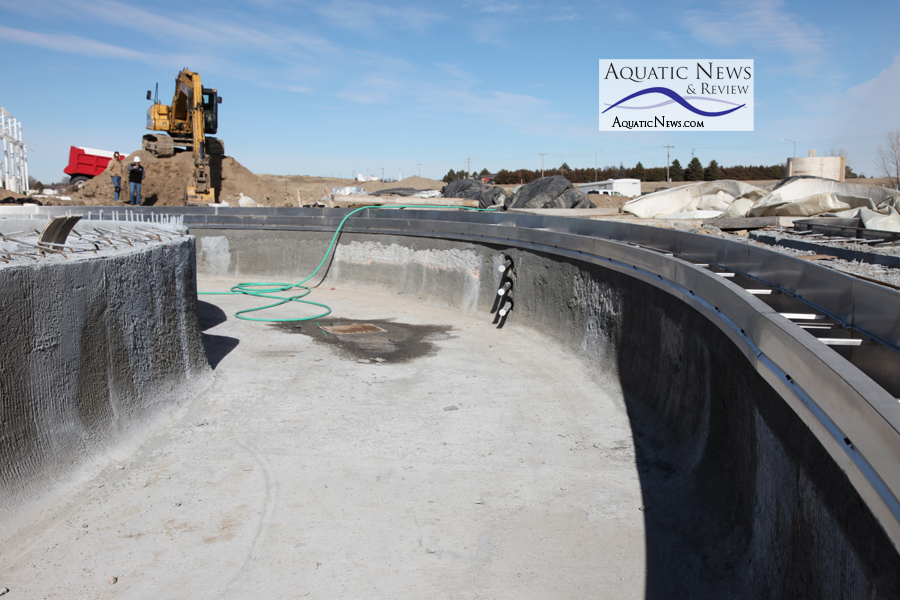
Like with shotcrete, the gunite nozzle operator uses a back-and-forth motion to sculpt the pool walls to the shape and thicknesses designed.
As has been discussed in depth already, the lower volume of water in gunite results in smaller changes in the concrete volume as it hydrates, with a resulting need for much fewer joints.
Like shotcrete, one thing that must be considered when using gunite in pools is the experience factor. It is critical with any construction that the contractor building the pool be highly experience with the methods of construction being used. With gunite, the person operating the gunite hose and nozzle is the absolute key to getting a great result from the concrete.
When done properly, gunite results in a much stronger and watertight installation than with cast-in-place. Gunite will result in even stronger concrete than shotcrete.
If constructed or designed incorrectly, any form of concrete work, including all three methods, will be disastrous. It is imperative that the pool contractor hired for the concrete work be highly experienced with the chosen method of concrete construction.
Pros & Cons of Gunite Concrete
Pros
- When properly designed and constructed, gunite will result in the strongest and most watertight concrete pools possible.
- Because of the lower volume of water used in the concrete mixture, there is less volume change through water hydration, which results in much fewer joints in the pool. Remember the rule of thumb for good pool design and construction is to “minimize the number of pool joints between concrete sections in the pool.”
- Higher compressive strengths than cast-in-place or shotcrete concrete. Typical compressive strengths of gunite are in the range of 7,500 to 9,000 psi.
- Properly constructed gunite has a smooth enough surface to be finished by epoxy-based paints or pool plasters.
- “Free form” application makes it possible to build very strong and watertight structures of any shape.
Cons
- Like all concrete installation, the contractor must be experienced and skilled in the particular technique of installation. There are even fewer people skilled in the use of gunite than that of cast-in-place or shotcrete concrete.
- Construction of pools using the gunite process is somewhat more time consuming than shotcrete, which usually results in a slightly higher construction cost.
- Few pool designers actually understand how to properly design gunite or shotcrete in swimming pool structures. The only reason this is listed as a con is the fact that the number of truly qualified concrete swimming pool designers is limited to a few. It is more an indictment of limited design knowledge than it is of gunite or shotcrete concrete.
Video of Gunite Concrete Construction of Commercial Pool Walls:
Conclusions and Recommendations
The many myths about shotcrete and gunite not being “concrete” pools actually originate with designers who just don’t know how to design good concrete pool structures other than cast-in-place, and contractors who cannot build shotcrete or gunite concrete pools. This is unfortunate since each type of concrete has its place, and knowledge of how to design and construct each will result in the best possible swimming pool structures that are very strong and watertight.
I need to begin this section by saying that every swimming pool or waterpark design is different and the types of structures used for each application need to be customized to meet the individual needs of each facility.
That being said, it is hard to beat a swimming pool structure that is concrete. Properly designed and constructed, concrete pools will last many decades with very little upkeep expense related to the structure.
Most of the pools we have designed over the years are concrete. Generally, the only time we use other materials for pool structures is when pool structure weight is a critical consideration, as is sometimes the case with pool construction in high-rise buildings. Even in these applications, we have designed several concrete pools in elevated buildings throughout the years. Each situation needs to be fully evaluated before deciding on the best construction techniques for the swimming pools.
Our typical design utilizes cast-in-place concrete for pool floors, in order to get a good uniform surface for pool users to walk on, with shotcrete concrete or gunite concrete for the pool walls in order to get very strong and watertight construction with few pool joints. Generally, the only time we use cast-in-place walls is when there is not a competent pool contractor with a good proven track record of shotcrete or gunite applied concrete walls available for the job.
My recommendation for you is to hire an expert aquatic facility designer who knows how to design every type of pool structure possible. If you talk with an “aquatic designer” who tells you one particular type of pool structure is the only way to go, find another pool designer, or better yet, contact me, Kevin McElyea, PE (913) 937-0099. I will gladly help you determine what is best for your project.
Pool Contractors with Extensive Experience in Shotcrete, Gunite, and Cast-in-place Concrete Construction
The following list of pool contractors have extensive experience in construction of swimming pools of all sorts, including those constructed of the concrete types listed in this article:
Please note that none of the contractors or manufacturers listed in this article have paid for such mention. We are including this information for the sole benefit of our readers to help them make informed decisions about their aquatic facility needs. If you need more information or help with your aquatic center, commercial swimming pool, or waterpark project, please contact our expert aquatic facility designers for more information.

